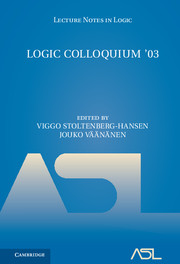Book contents
- Frontmatter
- Contents
- Introduction
- Colloquium Program
- TUTORIAL
- RESEARCH ARTICLES
- Indestructibility and strong compactness
- Some applications of regularmarkers
- Has the continuumhypothesis been settled?
- Geometry of interaction IV: the feedback equation
- On local modularity in homogeneous structures
- Descriptive set theory and uncountable model theory
- Decidable properties of logical calculi and of varieties of algebras
- Stabilization — an alternative to double-negation translation for classical natural deduction
- Definability and reducibility in higher types over the reals
- Predicativity problems in point-free topology
- Rank inequalities in the theory of differentially closed fields
- Consistency and games— in search of new combinatorial principles
- Realizability for constructive Zermelo-Fraenkel set theory
- On long EF-equivalence in non-isomorphic models
- The theory of is undecidable
- Cocovering and set forcing
- References
Abstract versus concrete computability: the case of countable algebras
from RESEARCH ARTICLES
Published online by Cambridge University Press: 30 March 2017
- Frontmatter
- Contents
- Introduction
- Colloquium Program
- TUTORIAL
- RESEARCH ARTICLES
- Indestructibility and strong compactness
- Some applications of regularmarkers
- Has the continuumhypothesis been settled?
- Geometry of interaction IV: the feedback equation
- On local modularity in homogeneous structures
- Descriptive set theory and uncountable model theory
- Decidable properties of logical calculi and of varieties of algebras
- Stabilization — an alternative to double-negation translation for classical natural deduction
- Definability and reducibility in higher types over the reals
- Predicativity problems in point-free topology
- Rank inequalities in the theory of differentially closed fields
- Consistency and games— in search of new combinatorial principles
- Realizability for constructive Zermelo-Fraenkel set theory
- On long EF-equivalence in non-isomorphic models
- The theory of is undecidable
- Cocovering and set forcing
- References
Summary
Abstract. We consider the distinction between abstract computability, in which computation is independent of data representations, and concrete computability, in which computations are dependent on data representations. The distinction is useful for current research in computability theories for continuous data and uncountable structures, including topological algebras and higher types. The distinction is also interesting in the seemingly simple case of discrete data and countable algebras. We give some theorems about equivalences and inequivalences between abstract models (e.g., computation with ‘while’ programs) and concrete models (e.g., computation via numberings) in the countable case.
Introduction. By a computability theory we mean a theory of functions and sets that are definable using a model of computation. By a model of computation we mean a model of some general method of calculating the value of a function or of deciding, or enumerating, the elements of a set. We allow the functions and sets to be made from any kind of data.
With this terminology, Classical Computability Theory on the set N of natural numbers is made up of many computability theories. The computable functions and computably enumerable sets are definable by scores of models of computation, based on scores of ideas about machines, programs, algorithms, specifications, rewriting systems, and calculi. It was an important early discovery, in 1936, that different models of computation can be shown to define the same classes of functions and sets. The fact that diverse computability models lead to the same classes of functions and sets on N is the main pillar supporting the Church-Turing Thesis, which gives the classical theory on N its extraordinary unity.
Starting in the 1940s, computability theories have been created for other special sets of data, including:
• higher types over the natural numbers,
• ordinals and set hierarchies,
• real numbers and Banach spaces, and
• higher types over real numbers.
- Type
- Chapter
- Information
- Logic Colloquium '03 , pp. 377 - 408Publisher: Cambridge University PressPrint publication year: 2006
References
- 3
- Cited by

